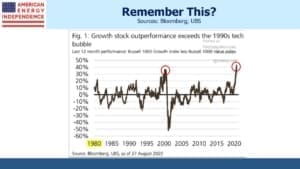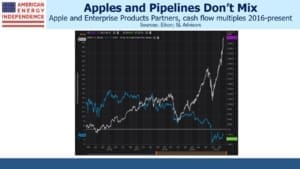Tech Stocks Have Energy
Relative valuations are provoking comparisons with past episodes that ended poorly, such as the late 1990s tech bubble. Tesla (TSLA) has risen 75% since announcing its 5:1 split on August 11th. Apple (AAPL), and their 4:1 split caused Exxon Mobil (XOM) to be dumped out for the Dow (see The Dow’s Odd Construction).
There are plenty of articles comparing growth with value. For an energy flavor, consider the comparison with pipeline company Enterprise Products Partners (EPD). As recently as early last year, like AAPL, it traded at under 10X cash flow. Their paths soon diverged, and this year’s Covid-inspired tech rally has led us to the surreal moment at which EPD would need to increase in price by 4.5X, or AAPL drop by 78%, in order for their cash flow multiples to be synchronized once again. AAPL’s net income over the past five years has varied between $46BN and $59BN, with $56BN expected this year. A reduced sharecount due to buybacks makes the EPS figures look better but, unsurprisingly with $50BN+ in anual profit, AAPL is no longer a high growth company.
Technology has been hot to be sure, but in spite of what a cursory glance might suggest, the energy sector has not been completely abandoned. Investors who purchased EPD’s 5.1% 2045 maturity bonds issued in February 2014 have been handsomely rewarded – at least by the extremely modest standards which bond buyers have long accepted. At the time, the cash flow yield on EPD’s stock was modestly higher than the bond yield, which probably convinced some that the bonds, with their fixed coupons and no participation in EPD’s future cash flow growth, weren’t cheap enough.
Those original investors have received their 5.1% coupon and enjoyed some modest price appreciation, since their bonds are now priced at around 120. This is in spite of making their purchase less than six months before energy stocks peaked. Since then, the Shale Revolution has been ruthlessly crushed, leaving energy stocks in disorderly retreat and sweeping EPD down with the rest. Since few bond investors have the flexibility to leap down the capital structure no matter how compelling the opportunity, the holders of this debt with 25 years yet remaining must regard EPD’s equity as altogether divorced from reality.
The change in valuations has been stunningly swift, and when the relationship between EPD’s stock and almost every other non-energy equity security is reverting to the mean, it will have all seemed inevitable. Until then, we can simply gaze at charts like these and wonder how the CFA curriculum will one day turn this into a teachable moment.
We are invested in all the components of the American Energy Independence Index via the ETF that seeks to track its performance.
Important Disclosures
The information provided is for informational purposes only and investors should determine for themselves whether a particular service, security or product is suitable for their investment needs. The information contained herein is not complete, may not be current, is subject to change, and is subject to, and qualified in its entirety by, the more complete disclosures, risk factors and other terms that are contained in the disclosure, prospectus, and offering. Certain information herein has been obtained from third party sources and, although believed to be reliable, has not been independently verified and its accuracy or completeness cannot be guaranteed. No representation is made with respect to the accuracy, completeness or timeliness of this information. Nothing provided on this site constitutes tax advice. Individuals should seek the advice of their own tax advisor for specific information regarding tax consequences of investments. Investments in securities entail risk and are not suitable for all investors. This site is not a recommendation nor an offer to sell (or solicitation of an offer to buy) securities in the United States or in any other jurisdiction.
References to indexes and benchmarks are hypothetical illustrations of aggregate returns and do not reflect the performance of any actual investment. Investors cannot invest in an index and do not reflect the deduction of the advisor’s fees or other trading expenses. There can be no assurance that current investments will be profitable. Actual realized returns will depend on, among other factors, the value of assets and market conditions at the time of disposition, any related transaction costs, and the timing of the purchase. Indexes and benchmarks may not directly correlate or only partially relate to portfolios managed by SL Advisors as they have different underlying investments and may use different strategies or have different objectives than portfolios managed by SL Advisors (e.g. The Alerian index is a group MLP securities in the oil and gas industries. Portfolios may not include the same investments that are included in the Alerian Index. The S & P Index does not directly relate to investment strategies managed by SL Advisers.)
This site may contain forward-looking statements relating to the objectives, opportunities, and the future performance of the U.S. market generally. Forward-looking statements may be identified by the use of such words as; “believe,” “expect,” “anticipate,” “should,” “planned,” “estimated,” “potential” and other similar terms. Examples of forward-looking statements include, but are not limited to, estimates with respect to financial condition, results of operations, and success or lack of success of any particular investment strategy. All are subject to various factors, including, but not limited to general and local economic conditions, changing levels of competition within certain industries and markets, changes in interest rates, changes in legislation or regulation, and other economic, competitive, governmental, regulatory and technological factors affecting a portfolio’s operations that could cause actual results to differ materially from projected results. Such statements are forward-looking in nature and involves a number of known and unknown risks, uncertainties and other factors, and accordingly, actual results may differ materially from those reflected or contemplated in such forward-looking statements. Prospective investors are cautioned not to place undue reliance on any forward-looking statements or examples. None of SL Advisors LLC or any of its affiliates or principals nor any other individual or entity assumes any obligation to update any forward-looking statements as a result of new information, subsequent events or any other circumstances. All statements made herein speak only as of the date that they were made. r
Certain hyperlinks or referenced websites on the Site, if any, are for your convenience and forward you to third parties’ websites, which generally are recognized by their top level domain name. Any descriptions of, references to, or links to other products, publications or services does not constitute an endorsement, authorization, sponsorship by or affiliation with SL Advisors LLC with respect to any linked site or its sponsor, unless expressly stated by SL Advisors LLC. Any such information, products or sites have not necessarily been reviewed by SL Advisors LLC and are provided or maintained by third parties over whom SL Advisors LLC exercise no control. SL Advisors LLC expressly disclaim any responsibility for the content, the accuracy of the information, and/or quality of products or services provided by or advertised on these third-party sites.
All investment strategies have the potential for profit or loss. Different types of investments involve varying degrees of risk, and there can be no assurance that any specific investment will be suitable or profitable for a client’s investment portfolio.
Past performance of the American Energy Independence Index is not indicative of future returns.





Not only bondholders but equity holders (including me) view EPD’s unit price and yield as “divorced from reality”. In addition to having a sustainable yield almost twice the coupon on the 2045 bonds, the equity yield is tax deferred and the portion of EPD’s earnings and profits allocated to the limited partners has a 20% deduction under Code section 199A.